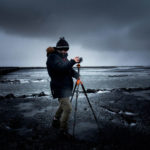
The term depth of field refers to how much of your picture is in sharp focus. For example, in portrait shots you will notice that the background is often blurred and soft looking, while the subject is clear and sharp. Pictures like this have a shallow depth of field.
You have probably also noticed that in landscape shots everything in the picture is often sharp and clear, all the way from the dead tree in the foreground to the mountains off in the distance. Pictures like this have a deep depth of field.
There are two main things that affect depth of field:
- The aperture (or F stop) setting–this refers to how wide the shutter opens.
- The focal length of the lens–this refers to how much the lens “zooms in” your subject.
First we’ll take a look at the aperture settings. Most digital cameras have an aperture range of about F2.8 to F8, and this range usually compresses to about F4.5 to F8 when using full zoom. These aperture ranges vary somewhat from camera to camera, but we will use F2.8 to F8, with a full zoom range of F4.5 to F8, as our example.
At the lowest setting (F2.8), the object you focus on will be sharp, but objects in the background will appear softer and out of focus. At the highest setting (F8), everything from the foreground of your picture to the objects off in the distance will appear sharp and in focus.
Now the focal length–we’ll use a digital camera with a 4 times zoom (35mm to 140mm focal length) as our example. At the 35mm end of your zoom range (no zoom), pretty much everything in your pictures will appear in focus. However, at the 140mm end of your zoom range (full zoom), only the object you focus on will appear sharp.
So how does all this translate into making better pictures with your digital camera? Well, it’s like this:

If you want to take a picture where only your subject is in focus (like a portrait for example), first, zoom in rather than get close, and second, choose an aperture setting with the lowest number possible, in this case F4.5.
If you want to take a picture where the whole scene is in focus (like a landscape for example), first, zoom in very little or not at all, and second, choose an aperture setting at or near the highest number possible, in this case F8.
So, don’t be shy, take your camera off of “auto” and try the “aperture priority” setting–you’ll be glad you did.
For more digital photography tips, high quality prints, free wallpaper, and eBooks, visit my web site: http://www.jeffgalbraithphotography.ca
Like This Article?
Don't Miss The Next One!
Join over 100,000 photographers of all experience levels who receive our free photography tips and articles to stay current:






Hi,
“Most digital cameras have an aperture range of about F2.8 to F8, and this range usually compresses to about F4.5 to F8 when using full zoom”
how was it or what does it mean that the aperture range compresses to something about F4.5 to F8 on full zoom?
Thanks